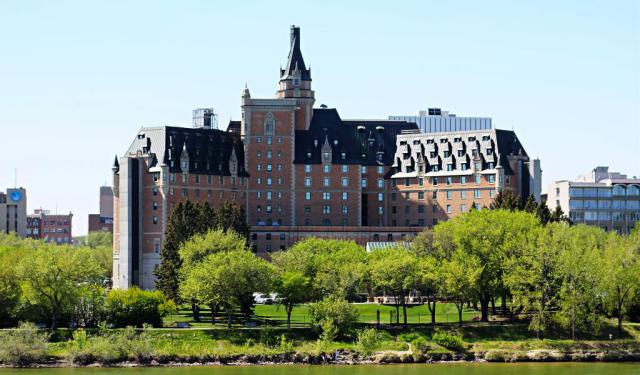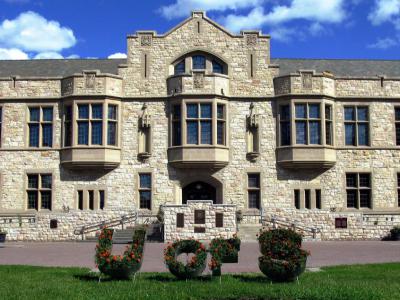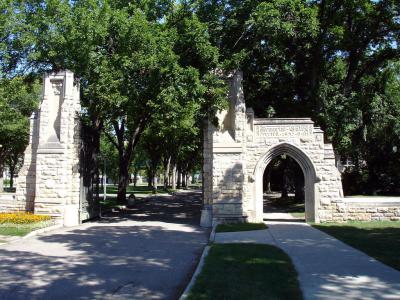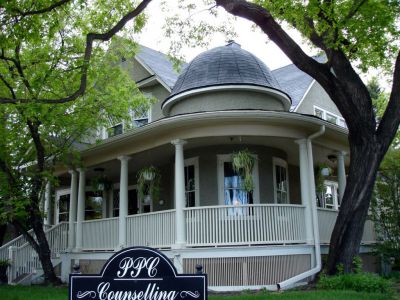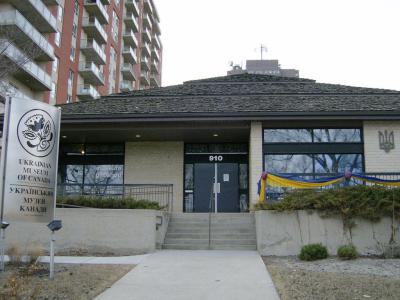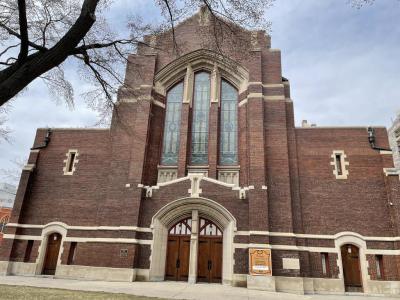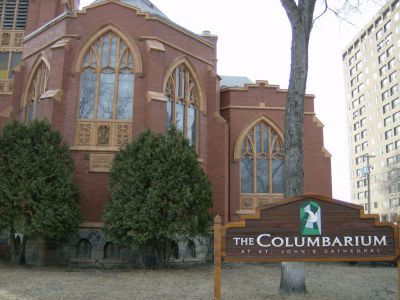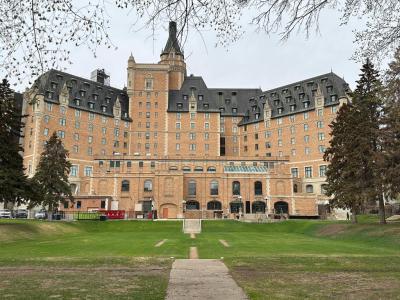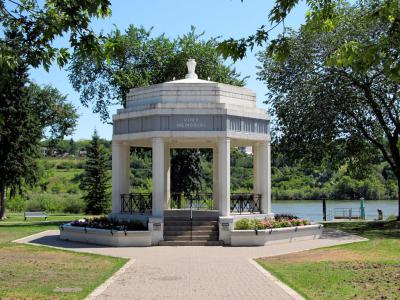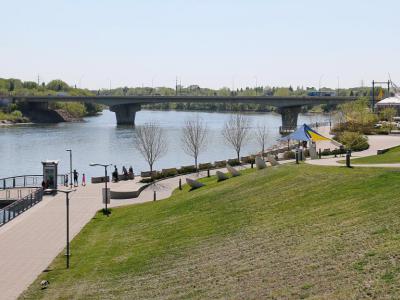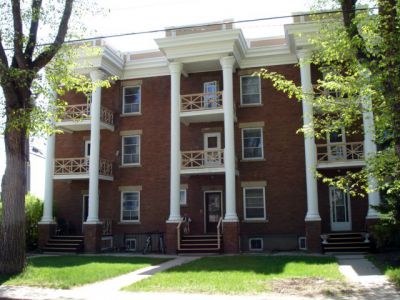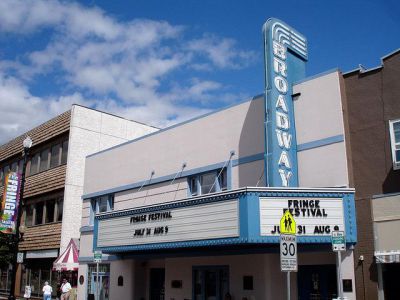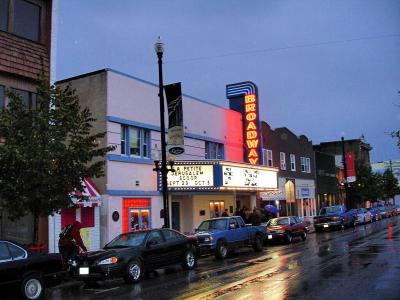Saskatoon Introduction Walking Tour (Self Guided), Saskatoon
Saskatoon, often referred to as the "City of Bridges," is the largest city in Canada's Saskatchewan province. Nestled on the banks of the South Saskatchewan River, it offers a compelling narrative stretching back to its founding in 1882. Historically, Saskatoon began as a Temperance colony established by a group of people who sought to escape the liquor trade in Toronto and set up a "dry" (i.e. free from alcoholic drink) community in the Prairie region. This backdrop adds a unique layer to city's diverse cultural foundation.
A town charter for the west side of the river was obtained in 1903, and this settlement adopted the name Saskatoon. The name itself is derived from the Cree word which refers to the violet-colored serviceberry that grows abundantly in the area, a sweet hint at the lush local natural resources.
By the mid-1950s, Saskatoon expanded from a town to a city, incorporating nearby communities, and came to be known as "Paris of the Prairies", renowned for its diverse and vibrant culture.
Today, the city is also known for its youthful energy, largely due to the influence of the University of Saskatchewan, one of Canada’s top universities. Saint Andrew’s College, another notable institution located on the university campus, is focused on religious studies.
For those interested in cultural explorations, the Ukrainian Museum of Canada offers insights into the significant contributions of Ukrainian immigrants to Saskatchewan.
The Delta Bessborough Hotel, often referred to as the ‘castle on the river’, is a landmark of luxury and history, whose chateau-style appearance adds a touch of old-world charm to the city skyline. Nearby, the Vimy Memorial honors local heroes and is a poignant reminder of Canada’s wartime sacrifices.
Saskatoon’s River Landing and the Meewasin Valley Trail provide expansive spaces for outdoor activities and relaxation, offering breathtaking views along the riverfront. The Broadway Bridge, another significant site, connects the vibrant Broadway Avenue-a hub for shopping, dining, and entertainment-to the heart of the city. Here, the historical Arrand Block, the art-deco Broadway Theatre, and the lively street life showcase Saskatoon’s dynamic cultural scene.
For anyone keen on exploring a city that perfectly balances historical reverence with modern vibrancy, a visit to Saskatoon is highly recommended. Don’t miss the opportunity to delve into its unique heritage and contemporary charm. Plan your visit today and discover the welcoming spirit of Saskatchewan!
A town charter for the west side of the river was obtained in 1903, and this settlement adopted the name Saskatoon. The name itself is derived from the Cree word which refers to the violet-colored serviceberry that grows abundantly in the area, a sweet hint at the lush local natural resources.
By the mid-1950s, Saskatoon expanded from a town to a city, incorporating nearby communities, and came to be known as "Paris of the Prairies", renowned for its diverse and vibrant culture.
Today, the city is also known for its youthful energy, largely due to the influence of the University of Saskatchewan, one of Canada’s top universities. Saint Andrew’s College, another notable institution located on the university campus, is focused on religious studies.
For those interested in cultural explorations, the Ukrainian Museum of Canada offers insights into the significant contributions of Ukrainian immigrants to Saskatchewan.
The Delta Bessborough Hotel, often referred to as the ‘castle on the river’, is a landmark of luxury and history, whose chateau-style appearance adds a touch of old-world charm to the city skyline. Nearby, the Vimy Memorial honors local heroes and is a poignant reminder of Canada’s wartime sacrifices.
Saskatoon’s River Landing and the Meewasin Valley Trail provide expansive spaces for outdoor activities and relaxation, offering breathtaking views along the riverfront. The Broadway Bridge, another significant site, connects the vibrant Broadway Avenue-a hub for shopping, dining, and entertainment-to the heart of the city. Here, the historical Arrand Block, the art-deco Broadway Theatre, and the lively street life showcase Saskatoon’s dynamic cultural scene.
For anyone keen on exploring a city that perfectly balances historical reverence with modern vibrancy, a visit to Saskatoon is highly recommended. Don’t miss the opportunity to delve into its unique heritage and contemporary charm. Plan your visit today and discover the welcoming spirit of Saskatchewan!
How it works: Download the app "GPSmyCity: Walks in 1K+ Cities" from Apple App Store or Google Play Store to your mobile phone or tablet. The app turns your mobile device into a personal tour guide and its built-in GPS navigation functions guide you from one tour stop to next. The app works offline, so no data plan is needed when traveling abroad.
Saskatoon Introduction Walking Tour Map
Guide Name: Saskatoon Introduction Walking Tour
Guide Location: Canada » Saskatoon (See other walking tours in Saskatoon)
Guide Type: Self-guided Walking Tour (Sightseeing)
# of Attractions: 13
Tour Duration: 2 Hour(s)
Travel Distance: 4.0 Km or 2.5 Miles
Author: Dee
Sight(s) Featured in This Guide:
Guide Location: Canada » Saskatoon (See other walking tours in Saskatoon)
Guide Type: Self-guided Walking Tour (Sightseeing)
# of Attractions: 13
Tour Duration: 2 Hour(s)
Travel Distance: 4.0 Km or 2.5 Miles
Author: Dee
Sight(s) Featured in This Guide:
- University of Saskatchewan and St. Andrew’s College
- Memorial Gates
- Bottomley House
- Ukrainian Museum of Canada
- Knox United Church
- Cathedral of St. John the Evangelist
- Delta Bessborough Hotel
- Vimy Memorial
- River Landing and Meewasin Valley Trail
- Broadway Bridge
- Arrand Block
- Broadway Theatre
- Broadway Avenue
1) University of Saskatchewan and St. Andrew’s College (must see)
The University of Saskatchewan (U of S), founded in 1907, is a leading public research institution in Saskatoon,. Established through a provincial legislature act, the university was created to provide comprehensive higher education to all, regardless of race, creed, or religion. Nestled on the east bank of the South Saskatchewan River, the expansive 359-acre campus is home to a blend of historic and modern architecture, reflecting its long-standing heritage and forward-looking vision.
The early structures at the University of Saskatchewan were constructed using a distinctive native limestone called greystone, quarried from a site just north of the campus. This greystone became an iconic feature of the university's architecture, creating a recognizable and unique aesthetic. The university's original architectural blueprint envisioned the campus buildings arranged around a central green area, known as The Bowl. This concept created a cohesive and scenic heart for the university. Over time, the historic buildings encircling The Bowl have been connected through a network of skywalks and underground tunnels.
Among its notable structures is Saint Andrew’s College, constructed in 1922 in the Collegiate Gothic style. Originally founded as the Presbyterian Theological College in 1912, Saint Andrew's College holds historical and architectural significance. It was officially recognized by the Saskatchewan Legislature in 1913 and has since become a cornerstone of theological education in Saskatoon. The building’s architectural style, characterized by vertical lines, symmetrical massing, and intricate Gothic motifs, exemplifies the tradition and prestige associated with older, established universities.
The college’s alumni include prominent figures such as Lydia Gruchy, the first woman ordained in the United Church of Canada, and Lorne Calvert, former Premier of Saskatchewan, showcasing its lasting impact on religious and public life in Canada.
The early structures at the University of Saskatchewan were constructed using a distinctive native limestone called greystone, quarried from a site just north of the campus. This greystone became an iconic feature of the university's architecture, creating a recognizable and unique aesthetic. The university's original architectural blueprint envisioned the campus buildings arranged around a central green area, known as The Bowl. This concept created a cohesive and scenic heart for the university. Over time, the historic buildings encircling The Bowl have been connected through a network of skywalks and underground tunnels.
Among its notable structures is Saint Andrew’s College, constructed in 1922 in the Collegiate Gothic style. Originally founded as the Presbyterian Theological College in 1912, Saint Andrew's College holds historical and architectural significance. It was officially recognized by the Saskatchewan Legislature in 1913 and has since become a cornerstone of theological education in Saskatoon. The building’s architectural style, characterized by vertical lines, symmetrical massing, and intricate Gothic motifs, exemplifies the tradition and prestige associated with older, established universities.
The college’s alumni include prominent figures such as Lydia Gruchy, the first woman ordained in the United Church of Canada, and Lorne Calvert, former Premier of Saskatchewan, showcasing its lasting impact on religious and public life in Canada.
2) Memorial Gates
The Memorial Gates, located at the University of Saskatchewan, stand as a poignant tribute to the university's alumni who sacrificed their lives during the Great War (World War I). Initially envisioned as the primary entrance to the university, these gates were constructed in 1927 to honor the memory of those students and faculty members who left their academic pursuits to serve in the conflict. Their names are inscribed on the gates, serving as a lasting testament to their bravery and the profound impact of their loss on the university community.
Due to the increasing volume of vehicular traffic in the area, the university eventually decided to relocate its main entrance closer to the Royal University Hospital. Despite this change, the Memorial Gates have retained their symbolic significance and continue to be a focal point of remembrance on campus. They stand not only as an architectural feature but also as a historical monument, embodying the spirit of sacrifice and the deep connections between the university and its community during times of national challenge.
Due to the increasing volume of vehicular traffic in the area, the university eventually decided to relocate its main entrance closer to the Royal University Hospital. Despite this change, the Memorial Gates have retained their symbolic significance and continue to be a focal point of remembrance on campus. They stand not only as an architectural feature but also as a historical monument, embodying the spirit of sacrifice and the deep connections between the university and its community during times of national challenge.
3) Bottomley House
The Bottomley House, a distinguished architectural gem located near the Memorial Gates of the University of Saskatchewan in Saskatoon, was built in 1912. This two-storey residence exemplifies the Queen Anne Revival style, characterized by its intricate wooden construction, numerous windows, and a uniquely shaped verandah that gracefully wraps around a corner of the house. Its name originates from its first owner, Richard Bottomley, but it was later acquired by Richard Kerr, who preserved its original design, maintaining its historical and aesthetic integrity.
The house’s proximity to the university and its prominent architectural style have made it a notable landmark in Saskatoon. Its Queen Anne Revival elements, such as the expansive verandah and elaborate woodwork, contribute to its charm and historical value. Over the years, the Bottomley House has become more than just a residence; it stands as a testament to early 20th-century architecture and the city’s historical landscape, enhancing its cultural significance and connection to the local heritage.
The house’s proximity to the university and its prominent architectural style have made it a notable landmark in Saskatoon. Its Queen Anne Revival elements, such as the expansive verandah and elaborate woodwork, contribute to its charm and historical value. Over the years, the Bottomley House has become more than just a residence; it stands as a testament to early 20th-century architecture and the city’s historical landscape, enhancing its cultural significance and connection to the local heritage.
4) Ukrainian Museum of Canada
The Ukrainian Museum of Canada, is a vibrant testament to the rich cultural heritage and history of Ukrainian Canadians. Founded in 1936, it holds the distinction of being the first museum of its kind in Canada. The museum has become a cultural beacon in the community, preserving and showcasing the diverse traditions and historical experiences of Ukrainian immigrants and their descendants.
Visitors to the museum are treated to an array of exhibits that vividly depict various aspects of Ukrainian culture. Among the highlights are traditional Ukrainian clothing, intricately woven linens, and a variety of tools that reflect the daily lives and craftsmanship of Ukrainian ancestors. The museum also boasts an extensive collection of books, photographs, and documents that provide a comprehensive look into the history and contributions of Ukrainians in Canada. Additionally, the museum houses religious items and wooden carvings, each piece telling a unique story of faith and artistry.
One of the most captivating collections within the museum is the display of pysanky, or Ukrainian Easter eggs. These beautifully decorated eggs are a symbol of Ukrainian folk art, known for their intricate designs and vibrant colors. The pysanky collection at the museum is a true marvel, showcasing the skill and creativity involved in this traditional craft. Each egg is a work of art, reflecting the cultural significance and artistic heritage of the Ukrainian people.
The museum also features a gift shop, where visitors can purchase authentic Ukrainian clothing and gifts. This shop provides an opportunity for guests to take a piece of Ukrainian culture home with them, whether it be through traditional embroidered garments, handcrafted jewelry, or other unique souvenirs.
Visitors to the museum are treated to an array of exhibits that vividly depict various aspects of Ukrainian culture. Among the highlights are traditional Ukrainian clothing, intricately woven linens, and a variety of tools that reflect the daily lives and craftsmanship of Ukrainian ancestors. The museum also boasts an extensive collection of books, photographs, and documents that provide a comprehensive look into the history and contributions of Ukrainians in Canada. Additionally, the museum houses religious items and wooden carvings, each piece telling a unique story of faith and artistry.
One of the most captivating collections within the museum is the display of pysanky, or Ukrainian Easter eggs. These beautifully decorated eggs are a symbol of Ukrainian folk art, known for their intricate designs and vibrant colors. The pysanky collection at the museum is a true marvel, showcasing the skill and creativity involved in this traditional craft. Each egg is a work of art, reflecting the cultural significance and artistic heritage of the Ukrainian people.
The museum also features a gift shop, where visitors can purchase authentic Ukrainian clothing and gifts. This shop provides an opportunity for guests to take a piece of Ukrainian culture home with them, whether it be through traditional embroidered garments, handcrafted jewelry, or other unique souvenirs.
5) Knox United Church
Knox United Church is a cherished municipal heritage building. Its history dates back to 1885, when the congregation was established as part of the Saskatoon Presbyterian Field Mission following the North-West Rebellion. Early meetings took place in various locations, including homes, the Old Stone Schoolhouse, the Methodist Church, and even the railway roundhouse, until a modest wooden church was built near the river to accommodate 160 attendees.
The present-day church, designed by architects Brown and Vallance of Montreal, is a stunning example of Collegiate Gothic architecture. Construction of the two-storey building began in 1912 and was completed in 1914. The structure is notable for its dark red brick walls and magnificent stained-glass windows, which add to its serene and reverent atmosphere. With a seating capacity of 1,200, the church stands as a significant architectural and historical landmark in Saskatoon.
Knox United Church is not only a place of worship but also a hub for social and cultural activities in the community. Its excellent acoustic qualities have made it a preferred venue for a variety of events, particularly chamber music performances. The church's large and beautiful interior provides a fitting backdrop for these events, attracting audiences who appreciate both the visual and auditory splendor.
The present-day church, designed by architects Brown and Vallance of Montreal, is a stunning example of Collegiate Gothic architecture. Construction of the two-storey building began in 1912 and was completed in 1914. The structure is notable for its dark red brick walls and magnificent stained-glass windows, which add to its serene and reverent atmosphere. With a seating capacity of 1,200, the church stands as a significant architectural and historical landmark in Saskatoon.
Knox United Church is not only a place of worship but also a hub for social and cultural activities in the community. Its excellent acoustic qualities have made it a preferred venue for a variety of events, particularly chamber music performances. The church's large and beautiful interior provides a fitting backdrop for these events, attracting audiences who appreciate both the visual and auditory splendor.
6) Cathedral of St. John the Evangelist
The Cathedral of Saint John the Evangelist began its journey in 1902, marking the establishment of Saskatoon's first Anglican parish. The initial church structure, a wooden frame building, was constructed in 1903, laying the foundation for what would become a significant landmark in the city's spiritual landscape.
The current edifice, constructed between 1912 and 1917, is an unadorned yet striking example of neo-Gothic architecture. Made from brick, Tyndall stone, and terra cotta, the building's design is both sturdy and elegant. One of its most distinguishing features is the rood screen at the chancel steps, along with the pulpit, lectern, and high altar, all crafted from Carrara ware-a white terra cotta resembling Italian Carrara marble.
The cornerstone of this architectural marvel was laid in 1912 by Prince Arthur, Duke of Connaught, who was the Governor General of Canada at the time. Initially designated as a pro-cathedral in 1924 while Saskatoon was still part of the Anglican Diocese of Saskatchewan, Saint John's gained full cathedral status in 1932 with the creation of the Diocese of Saskatoon.
The musical heritage of the cathedral also evolved over time. For many years, it relied on a small reed organ and piano. However, in 1956, a significant enhancement was made with the installation of a three-manual Hill, Norman and Beard organ, which was later replaced by a two-manual Casavant Frères organ in 1981-1982, enriching the cathedral's liturgical and cultural offerings.
The current edifice, constructed between 1912 and 1917, is an unadorned yet striking example of neo-Gothic architecture. Made from brick, Tyndall stone, and terra cotta, the building's design is both sturdy and elegant. One of its most distinguishing features is the rood screen at the chancel steps, along with the pulpit, lectern, and high altar, all crafted from Carrara ware-a white terra cotta resembling Italian Carrara marble.
The cornerstone of this architectural marvel was laid in 1912 by Prince Arthur, Duke of Connaught, who was the Governor General of Canada at the time. Initially designated as a pro-cathedral in 1924 while Saskatoon was still part of the Anglican Diocese of Saskatchewan, Saint John's gained full cathedral status in 1932 with the creation of the Diocese of Saskatoon.
The musical heritage of the cathedral also evolved over time. For many years, it relied on a small reed organ and piano. However, in 1956, a significant enhancement was made with the installation of a three-manual Hill, Norman and Beard organ, which was later replaced by a two-manual Casavant Frères organ in 1981-1982, enriching the cathedral's liturgical and cultural offerings.
7) Delta Bessborough Hotel
The Delta Bessborough hotel is a striking ten-story structure in downtown Saskatoon. Known for its distinctive castle-like appearance, the hotel stands as a historical landmark in the city. Constructed by the Canadian National Railway between 1928 and 1932, the Delta Bessborough is designed in the Château-style, characteristic of many of Canada's grand railway hotels. Locals affectionately refer to it as "The Bess," a testament to its enduring presence and significance. The hotel’s location provides a picturesque eastern terminating vista for Saskatoon’s 21st Street East and a prominent view terminus on Spadina Crescent from southern points.
With 225 guest rooms, the Delta Bessborough offers a blend of historic charm and modern amenities. The hotel boasts numerous meeting facilities and function rooms, making it a popular choice for conferences and events. One of the hotel's most appealing aspects is its extensive private waterfront gardens, covering 5 acres (20,000 square meters) and backing onto the river. These gardens serve as a scenic venue for various large functions, including weddings, business barbecues, retirement parties, concerts, and the Sasktel Saskatchewan Jazz Fest.
The Delta Bessborough’s historical and architectural significance extends beyond its physical structure. It has hosted numerous notable events, such as the Police and Fire Can-Am games in the summer of 2008, further cementing its role as a central hub for community activities and celebrations. The hotel's storied past and majestic design continue to attract both locals and visitors, contributing to its status as an iconic fixture in Saskatoon's skyline.
With 225 guest rooms, the Delta Bessborough offers a blend of historic charm and modern amenities. The hotel boasts numerous meeting facilities and function rooms, making it a popular choice for conferences and events. One of the hotel's most appealing aspects is its extensive private waterfront gardens, covering 5 acres (20,000 square meters) and backing onto the river. These gardens serve as a scenic venue for various large functions, including weddings, business barbecues, retirement parties, concerts, and the Sasktel Saskatchewan Jazz Fest.
The Delta Bessborough’s historical and architectural significance extends beyond its physical structure. It has hosted numerous notable events, such as the Police and Fire Can-Am games in the summer of 2008, further cementing its role as a central hub for community activities and celebrations. The hotel's storied past and majestic design continue to attract both locals and visitors, contributing to its status as an iconic fixture in Saskatoon's skyline.
8) Vimy Memorial
The Vimy Memorial, also known as the Vimy Memorial Bandshell, is a prominent open structure in Saskatoon's Kiwanis Park, situated on the bank of the South Saskatchewan River. Built in 1937, this memorial honors Canada's significant participation in the First World War, particularly the 1917 Battle of Vimy Ridge. This battle was a defining moment for Canada, involving 120,000 men from four Canadian divisions and resulting in 10,602 casualties, including 3,598 fatalities. The victory at Vimy Ridge was a major milestone, marking Canada's emergence from a British colony to an independent nation. During the Second World War, the Vimy Memorial also served as a hub for patriotic and war-related activities.
The inspiration for the Vimy Memorial came from a 1936 pilgrimage to Vimy, France, attended by 6,000 veterans and their families. Designed by the Kiwanis Club, the memorial pays tribute to those who sacrificed their lives in World War I and serves as a community gathering place for musical events.
Constructed of concrete and painted white, the bandshell features a semi-domed roof crowned with a lantern, supported by eight pillars. Steps lead to the band area, enclosed by an iron balustrade. The words "VIMY MEMORIAL" are carved in grey corrugated concrete above the entrance, and a brass plaque beside the steps reads: "ERECTED 1936 - 1937 BY THE KIWANIS CLUB TO COMMEMORATE THE BATTLE OF VIMY RIDGE 1915."
The inspiration for the Vimy Memorial came from a 1936 pilgrimage to Vimy, France, attended by 6,000 veterans and their families. Designed by the Kiwanis Club, the memorial pays tribute to those who sacrificed their lives in World War I and serves as a community gathering place for musical events.
Constructed of concrete and painted white, the bandshell features a semi-domed roof crowned with a lantern, supported by eight pillars. Steps lead to the band area, enclosed by an iron balustrade. The words "VIMY MEMORIAL" are carved in grey corrugated concrete above the entrance, and a brass plaque beside the steps reads: "ERECTED 1936 - 1937 BY THE KIWANIS CLUB TO COMMEMORATE THE BATTLE OF VIMY RIDGE 1915."
9) River Landing and Meewasin Valley Trail (must see)
River Landing is a transformative redevelopment project in Saskatoon that aims to create a vibrant commercial and cultural district along the banks of the South Saskatchewan River in the heart of downtown. This ambitious project is designed to revitalize the riverbank, providing a dynamic blend of residential, commercial, and recreational spaces that will enhance the urban landscape and community life in Saskatoon.
The redevelopment is being carried out in two distinct phases. The first phase focuses on the eastern part of River Landing and involves extensive waterfront redevelopment. This includes the construction of a hotel complex and a destination complex that will serve as a hub for cultural and social activities.
The Meewasin Valley Trail, spanning 60 kilometers along both sides of the South Saskatchewan River, offers a scenic and versatile pathway through Saskatoon. Winding its way under bridges and through lush city parks, the trail passes by major tourist attractions and historic sites, making it a favorite among locals and visitors alike. Starting at the River Landing riverfront promenade, you can enjoy a leisurely walk through the green space, which features benches, shaded picnic tables, lawns, and a water spray park for children. From there, the trail leads you to Friendship Park and Kiwanis Memorial Park, providing picturesque views and serene spots for relaxation.
Notably, about 20 kilometers of the Meewasin Valley Trail is part of The Great Trail, the world's largest network of recreational trails. This integration connects Saskatoon to a broader tapestry of trails across Canada.
The redevelopment is being carried out in two distinct phases. The first phase focuses on the eastern part of River Landing and involves extensive waterfront redevelopment. This includes the construction of a hotel complex and a destination complex that will serve as a hub for cultural and social activities.
The Meewasin Valley Trail, spanning 60 kilometers along both sides of the South Saskatchewan River, offers a scenic and versatile pathway through Saskatoon. Winding its way under bridges and through lush city parks, the trail passes by major tourist attractions and historic sites, making it a favorite among locals and visitors alike. Starting at the River Landing riverfront promenade, you can enjoy a leisurely walk through the green space, which features benches, shaded picnic tables, lawns, and a water spray park for children. From there, the trail leads you to Friendship Park and Kiwanis Memorial Park, providing picturesque views and serene spots for relaxation.
Notably, about 20 kilometers of the Meewasin Valley Trail is part of The Great Trail, the world's largest network of recreational trails. This integration connects Saskatoon to a broader tapestry of trails across Canada.
10) Broadway Bridge
The Broadway Bridge in Saskatoon is a prominent arch bridge that elegantly spans the South Saskatchewan River, linking the city's east and west banks. Constructed during the Great Depression as a "make-work" project, the bridge was built in 1932 by R.J. Arrand Construction Company. The design was the brainchild of Chalmers Jack (C. J.) MacKenzie, who was on leave from his role as Dean of Engineering at the University of Saskatchewan.
Initially known as the Dean's Bridge in recognition of MacKenzie's involvement, it was later formally named the Broadway Bridge to reflect its vital connection between Broadway Avenue on the east shore and 19th Street and 4th Avenue in Saskatoon's downtown core. At one point, there was even consideration of renaming it the George V Bridge in honor of the King.
The bridge's architectural style, featuring graceful arches, has made it a distinctive and beloved landmark in Saskatoon. One of the most iconic images of Saskatoon is the view of the Bessborough Hotel framed within one of the arches of the Broadway Bridge. This picturesque scene captures the blend of historical architecture and natural beauty that characterizes the city.
In late 2005, the nearby Traffic Bridge was closed for a year, significantly increasing the amount of daily traffic on the Broadway Bridge. This surge underscored the bridge's importance in the city's transportation network, as it efficiently accommodated the additional flow and continued to serve as a key artery for commuters and travelers. The bridge's ability to handle increased usage during this period highlighted its robust construction and strategic design.
Initially known as the Dean's Bridge in recognition of MacKenzie's involvement, it was later formally named the Broadway Bridge to reflect its vital connection between Broadway Avenue on the east shore and 19th Street and 4th Avenue in Saskatoon's downtown core. At one point, there was even consideration of renaming it the George V Bridge in honor of the King.
The bridge's architectural style, featuring graceful arches, has made it a distinctive and beloved landmark in Saskatoon. One of the most iconic images of Saskatoon is the view of the Bessborough Hotel framed within one of the arches of the Broadway Bridge. This picturesque scene captures the blend of historical architecture and natural beauty that characterizes the city.
In late 2005, the nearby Traffic Bridge was closed for a year, significantly increasing the amount of daily traffic on the Broadway Bridge. This surge underscored the bridge's importance in the city's transportation network, as it efficiently accommodated the additional flow and continued to serve as a key artery for commuters and travelers. The bridge's ability to handle increased usage during this period highlighted its robust construction and strategic design.
11) Arrand Block
The Arrand Block stands as a remarkable example of luxurious, neo-Classical architecture from the early 20th century. Constructed in 1912 during the city's building boom by the renowned James and Walter T. Arrand Contractors' Company, this three-storey brick apartment building was designed to cater to a specific, upscale clientele.
The Arrand Block is distinguished by its elegant architectural features, including neo-Classical columns that support ornate balconies, creating a unique and refined aesthetic. Originally, the building was divided into three expansive, two-storey apartments with three additional suites on the top floor, each featuring both front and back verandas. Although the back verandas were enclosed in 1926 to create sunrooms, the building has retained its original form and character.
A significant aspect of the Arrand Block's heritage value lies in its association with the Arrand family, who were prominent contractors and concrete specialists in Saskatoon. The Arrand cousins, James and Walter T., not only built the structure but also intended to reside in it themselves. The building's design elements, such as the upper-suite skylights and the circular iron fire escape nestled between the back verandas, showcase the attention to detail and the high standard of living that the Arrand family envisioned.
The Arrand Block's significance extends beyond its architectural beauty; it also represents the Arrand family's contribution to Saskatoon's development. The Arrand cousins' construction company was responsible for several of the city's notable structures, including the Broadway Bridge, the University Memorial Gates, the Saskatoon School for the Deaf, and the Capitol Theatre.
The Arrand Block is distinguished by its elegant architectural features, including neo-Classical columns that support ornate balconies, creating a unique and refined aesthetic. Originally, the building was divided into three expansive, two-storey apartments with three additional suites on the top floor, each featuring both front and back verandas. Although the back verandas were enclosed in 1926 to create sunrooms, the building has retained its original form and character.
A significant aspect of the Arrand Block's heritage value lies in its association with the Arrand family, who were prominent contractors and concrete specialists in Saskatoon. The Arrand cousins, James and Walter T., not only built the structure but also intended to reside in it themselves. The building's design elements, such as the upper-suite skylights and the circular iron fire escape nestled between the back verandas, showcase the attention to detail and the high standard of living that the Arrand family envisioned.
The Arrand Block's significance extends beyond its architectural beauty; it also represents the Arrand family's contribution to Saskatoon's development. The Arrand cousins' construction company was responsible for several of the city's notable structures, including the Broadway Bridge, the University Memorial Gates, the Saskatoon School for the Deaf, and the Capitol Theatre.
12) Broadway Theatre
The Broadway Theatre stands as a unique cultural institution and a beloved landmark. As Canada's only community-owned non-profit repertory cinema, it offers a distinctive blend of art films and live performances. The theatre, designed in the Streamline Moderne style by George Forrester, first opened its doors on December 5, 1946. During the post-World War II years, the Broadway Theatre became a popular entertainment destination, screening contemporary movies and hosting live musical performances on its stage.
However, starting in the 1950s, the surrounding neighborhood began to decline, and by the 1970s, the Broadway Theatre had also fallen into disrepute, transitioning into an "adult" movie theatre. This period marked a low point in its history, as the once-vibrant venue lost its former charm and respectability. The community, recognizing the theatre's cultural and historical value, rallied to restore it during the 1980s. This effort successfully transformed the Broadway Theatre into an art film cinema and live performance venue, breathing new life into the historic building.
In recognition of its architectural significance and its role in the community's cultural revival, the Broadway Theatre was designated a municipal heritage property on April 14, 1997. Today, it stands as a testament to the power of community action and the enduring appeal of classic cinema and live performance.
However, starting in the 1950s, the surrounding neighborhood began to decline, and by the 1970s, the Broadway Theatre had also fallen into disrepute, transitioning into an "adult" movie theatre. This period marked a low point in its history, as the once-vibrant venue lost its former charm and respectability. The community, recognizing the theatre's cultural and historical value, rallied to restore it during the 1980s. This effort successfully transformed the Broadway Theatre into an art film cinema and live performance venue, breathing new life into the historic building.
In recognition of its architectural significance and its role in the community's cultural revival, the Broadway Theatre was designated a municipal heritage property on April 14, 1997. Today, it stands as a testament to the power of community action and the enduring appeal of classic cinema and live performance.
13) Broadway Avenue (must see)
Broadway Avenue is a vibrant arterial road and commercial street in Saskatoon, known for its historical significance and bustling activity. Stretching from the east end of the Broadway Bridge and extending south for about four kilometers until terminating in a cul-de-sac in the Avalon neighborhood, Broadway Avenue is a key thoroughfare in the city. The street was named for its width, which originally allowed teams of more than two horses to make U-turns without needing to go around the block, a practical feature in its early days.
The commercial heart of Broadway Avenue, often referred to simply as "Broadway," encompasses the five blocks running south from the Broadway Bridge to 8th Street East, along with the adjoining blocks to the east and west. This area was the original main commercial street of Nutana, a town that later amalgamated with Saskatoon in 1906. Historically significant, it was home to the city's first elementary school, Victoria School. Although the original stone school building was relocated to the University of Saskatchewan, the replacement school built in the 1930s still stands, adding a historical touch to the avenue.
Today, this section forms the Broadway Business Improvement District, a lively hub for shopping, dining, and cultural activities. The area is dotted with numerous restaurants and bars, boutique shops, local businesses, and hosts annual street festivals, making it a popular destination for both residents and visitors. The Saskatoon Fringe Theatre Festival, held annually on Broadway Avenue, is a highlight that attracts performers and audiences from across the region, contributing to the street's dynamic and artistic atmosphere.
The commercial heart of Broadway Avenue, often referred to simply as "Broadway," encompasses the five blocks running south from the Broadway Bridge to 8th Street East, along with the adjoining blocks to the east and west. This area was the original main commercial street of Nutana, a town that later amalgamated with Saskatoon in 1906. Historically significant, it was home to the city's first elementary school, Victoria School. Although the original stone school building was relocated to the University of Saskatchewan, the replacement school built in the 1930s still stands, adding a historical touch to the avenue.
Today, this section forms the Broadway Business Improvement District, a lively hub for shopping, dining, and cultural activities. The area is dotted with numerous restaurants and bars, boutique shops, local businesses, and hosts annual street festivals, making it a popular destination for both residents and visitors. The Saskatoon Fringe Theatre Festival, held annually on Broadway Avenue, is a highlight that attracts performers and audiences from across the region, contributing to the street's dynamic and artistic atmosphere.
The Most Popular Cities
/ view all
